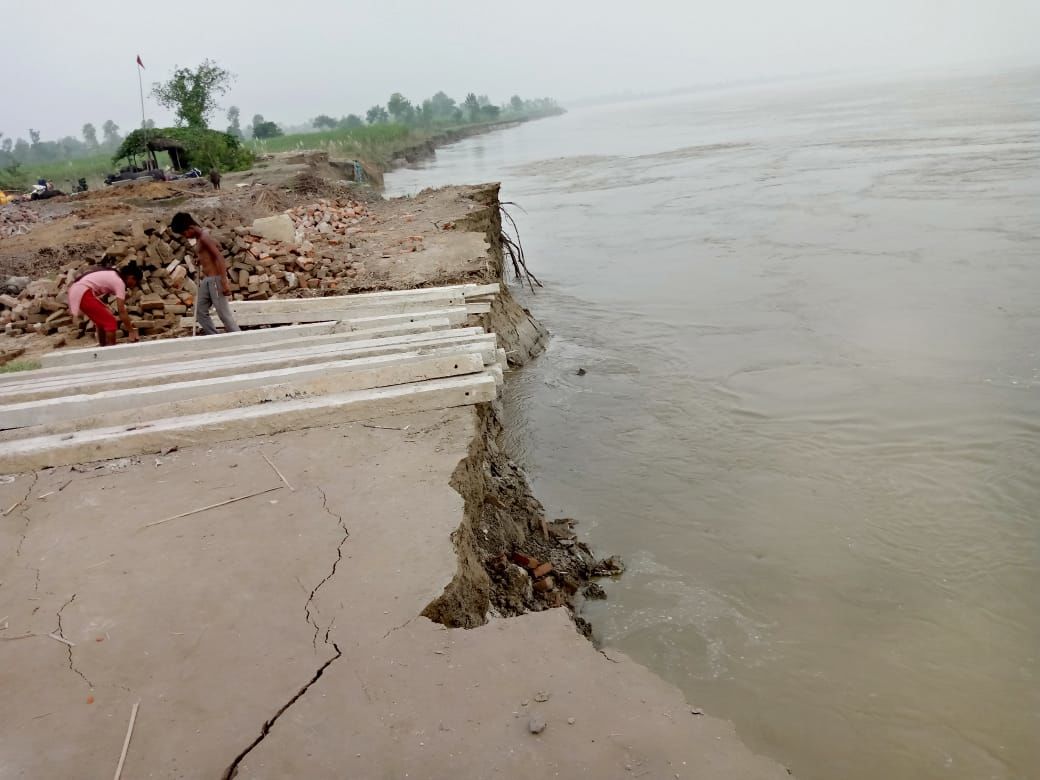IMD warns of flash floods in Bihar’s Pashchim Champaran; entire villages evacuated
The Paschim Champaran district is still reeling under two recent ‘flash floods’ that wreaked havoc in its villages. Now it is bracing up for another one on July 2.


As a precautionary measure, all the families in Serahwa village have moved with their belongings. All photos: By Arrangement
Bihar and floods are once again in the news. Flood alerts were issued in several districts of the state including Madhubani, Sitamarhi, Saran, and both Paschim (west) Champaran and Purba (east) Champaran.
An alert was issued by the India Meteorological Department for both Paschim and Purba Champaran districts for tomorrow (July 2). Several villages in Ramnagar block of the Pashchim Champaran district have been evacuated, in anticipation of another devastating flood after the recent floods of June 29 and 30, that had washed away the piles of bamboo on the banks that were placed there to act as a buffer from flood waters entering the villages.
Map: Heavy rain and thunderstorm alert forecast in Pashchim Champaran for July 2.

Also Read: Marooned for a month, villagers in Bihar have no access to sufficient food, healthcare, toilets
The bamboo piling work to prevent disasters was still underway when the floods washed them away.
In the early hours of June 29, just after midnight, flood waters entered the homes of many villagers in Gaunaha block of Pashchim Champaran. They had to seek shelter in the relatively safer homes of their neighbours, till the waters receded.
“The flood waters breached roads and entered our homes. Since the roads are damaged, it is very difficult to leave home for work,” Binita Kumari, a resident of Rupaliya village, told Gaon Connection.
Recalling the night of the floods, she said everyone was awake all night at the village. “Three families from my neighbourhood came to our house as water entered their homes,” she added.

Villages evacuated
As a precautionary measure, all the families in Serahwa village have moved with their belongings. “We fear the river will enter the villages again and wash everything away,” Ujjawal Kumar, from Inarbarwa village of Ramnagar in West Champaran, told Gaon Connection.
“This time the river eroded only 50 metres of land. Last time (June 14 and 15), it eroded nearly 400 metres of land. The bamboo-piling saved us from a worse fate, but that has all gone. We are now ram bharose (dependent on God),” rued Kumar.
“We did bamboo piling in a 500-metre area near Sehrawa village. But the recent floods damaged it. We are going to the site to assess the damage,” Lal Bahadur Gupta, executive engineer of the flood control department in Bettiah, told Gaon Connection. “Only when the water recedes can we start the repair work,” he added.

Neglected transboundary rivers
The Central Water Commission (a government body forecasts flash floods), has said that the Bagmati river in Muzaffarpur, Gandak river in Gopalganj, Kamla river in Madhubani and river Burhi Gandak in Samastipur continue to flow in ‘severe situation’.
The Commission said that widespread and heavy rainfall was observed in the Narayani catchment in Nepal (Gandak in India) and predicted further rainfall. It also warned of flooding in several districts of Bihar.
Also Read: Bihar floods: An annual blame game between India and Nepal
Heavy rainfall in Bihar and the neighbouring country of Nepal has led to flash floods in villages along the India-Nepal border in Paschim Champaran.
The Masan and Pandai rivers are wreaking havoc in nearby villages, washing away everything in their way. Both are transboundary rivers and tributaries of the Gandak. They have been in full spate for the past couple of days.
According to a study by Megh Pyne Abhiyan, a charitable trust that has been working on water and sanitation issues in the eastern part of the country, villages along the India-Nepal border in north Bihar face up to 66 flash floods a year. There are at least 148 small and seasonal transboundary rivers that flow into north Bihar from Nepal, and many of them cause flash floods causing recurring damage to property and human lives.
According to Eklavya Prasad, managing trustee of Megh Pyne Abhiyan, the government has been neglecting the small, yet important, transboundary rivers such as Masan and Pandai, and wakes up to their presence only during the monsoons.

Floods or water logging?
When asked about the flash floods in such quick succession (June 24-15 then again on June 29-30), Kundan Kumar, the district magistrate of Paschim Champaran, dismissed what had happened on June 15 and 16. He told Gaon Connection that “there were no flash floods. It was just water logging.
But experts working in the water sector refuse to accept Kundan Mumar’s verdict.
“They (officials) are deliberately creating confusion between water logging and floods. I have never seen water logging with such strong currents,” Prasad of Megh Pyne Abhiyan told Gaon Connection. He said if flash floods were described as water logging it would demolish the entire definition of floods.

Discussions only during floods
Preparations to tackle floods can only happen when the nature of the floods are understood properly and the ground reality is taken into account, Prasad said. He explained how there were three phases of floods. “There is the pre-flood situation; the floods as they happen, and the post flood scenario,” he said.
“Preparation happens only when you understand the nature of floods and ground reality,” he added. But, he regretted that usually authorities were galvanised into action, only during and after the floods.

